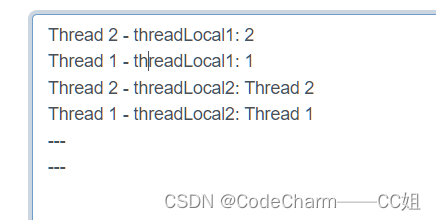【多线程】ThreadLocal 详解,举例说明
ThreadLocal 是 Java 中的一个线程级别的变量,用于在多线程环境下保持变量的独立性。每个线程都可以独立地设置和获取 ThreadLocal 的值,而不会影响其他线程。通常情况下,ThreadLocal 被用来在方法或类之间传递变量。
1、原理:
ThreadLocal 的实现原理是通过维护一个 Map,其中键为线程 ID,值为变量的值。每个线程都有一个唯一的 ID,通过这个 ID 将变量与线程关联起来。当调用 ThreadLocal 的 get 方法时,会根据当前线程的 ID 获取对应的值。当调用 set 方法时,会根据当前线程的 ID 设置对应的值。
2、为什么使用 ThreadLocal:
- 线程隔离:
ThreadLocal提供了一种线程隔离的机制,使得每个线程都可以拥有自己的变量,互不干扰。 - 避免参数传递: 在多线程环境下,为了传递变量,常常需要在方法之间传递参数。使用
ThreadLocal可以避免参数传递的繁琐工作,提高代码的简洁性。 - 线程上下文共享: 在某些情况下,需要在多个方法之间共享某个值,但又不希望使用全局变量。
ThreadLocal提供了一种线程级别的共享机制。
3、使用方法:
public class Example {
private static ThreadLocal<String> threadLocal = new ThreadLocal<>();
public static void main(String[] args) {
// 在线程中设置值
threadLocal.set("Hello, ThreadLocal!");
// 在不同的方法中获取值
method1();
method2();
}
public static void method1() {
// 从当前线程获取值
String value = threadLocal.get();
System.out.println("Method 1: " + value);
}
public static void method2() {
// 从当前线程获取值
String value = threadLocal.get();
System.out.println("Method 2: " + value);
}
}
需要注意的是,在使用完 ThreadLocal 后,尤其是在线程池等场景,应该及时调用 remove 方法,以避免内存泄漏。可以使用 ThreadLocal.remove() 或者使用 try-with-resources 语句块。
public class Example {
private static ThreadLocal<String> threadLocal = new ThreadLocal<>();
public static void main(String[] args) {
try {
threadLocal.set("Hello, ThreadLocal!");
// 在不同的方法中获取值
method1();
method2();
} finally {
// 及时清理 ThreadLocal,避免内存泄漏
threadLocal.remove();
}
}
// ...
}
在 Java 8 之后, ThreadLocal 还引入了 withInitial 方法,可以在创建 ThreadLocal 实例的同时初始化其值,进一步简化了使用。
3、实例
import java.util.concurrent.atomic.AtomicInteger;
public class ThreadLocalExample {
private static final ThreadLocal<Integer> threadLocal1 = new ThreadLocal<>();
private static final ThreadLocal<String> threadLocal2 = new ThreadLocal<>();
private static final AtomicInteger counter = new AtomicInteger(0);
public static void main(String[] args) {
Thread thread1 = new Thread(() -> {
int value = counter.incrementAndGet();
threadLocal1.set(value);
threadLocal2.set("Thread " + value);
printValues("Thread 1");
});
Thread thread2 = new Thread(() -> {
int value = counter.incrementAndGet();
threadLocal1.set(value);
threadLocal2.set("Thread " + value);
printValues("Thread 2");
});
thread1.start();
thread2.start();
}
private static void printValues(String threadName) {
System.out.println(threadName + " - threadLocal1: " + threadLocal1.get());
System.out.println(threadName + " - threadLocal2: " + threadLocal2.get());
System.out.println("---");
}
}
在这个例子中,两个线程分别递增 counter 并将其值设置到两个不同的 ThreadLocal 变量中。通过 printValues 方法打印每个线程的 ThreadLocal 变量值。由于每个线程有自己的 ThreadLocal 副本,它们之间不会互相干扰。
输出:

解释: 在这个代码中,有两个线程:thread1 和 thread2。它们共享一个 counter 变量,并使用 threadLocal1 和 threadLocal2 来存储线程本地的值。
.
thread1 启动,counter 的值为0,counter.incrementAndGet() 将 counter 的值增加为1,然后将1设置到 threadLocal1 和 threadLocal2 中。输出线程1的本地值。
.
thread2 启动,counter 的值为1,counter.incrementAndGet() 将 counter 的值增加为2,然后将2设置到 threadLocal1 和 threadLocal2 中。输出线程2的本地值。
.
因为 ThreadLocal 提供了线程本地的变量副本,所以每个线程都可以独立维护自己的值,互不干扰。这就是为什么输出结果中会有 Thread 1 - threadLocal1: 1 和 Thread 2 - threadLocal1: 2 的原因。
.
输出的顺序可能会有差异,因为线程调度的执行顺序不确定。但是每个线程内部的输出是一致的。
本文来自互联网用户投稿,该文观点仅代表作者本人,不代表本站立场。本站仅提供信息存储空间服务,不拥有所有权,不承担相关法律责任。 如若内容造成侵权/违法违规/事实不符,请联系我的编程经验分享网邮箱:chenni525@qq.com进行投诉反馈,一经查实,立即删除!
- Python教程
- 深入理解 MySQL 中的 HAVING 关键字和聚合函数
- Qt之QChar编码(1)
- MyBatis入门基础篇
- 用Python脚本实现FFmpeg批量转换
- 螺纹钢负公差测径仪获得哪些信息?
- 【CUDA】零基础入门教程合集
- 推荐两种原生JavaScript移除className的实用方式
- 梳理从MVP变换到光栅化的过程
- node.js mongoose schemaTypes
- 使用java房贷月供计算
- 【无标题】
- 高级路由技术案例
- 怎么修复MSVCR110.dll文件?全面解析MSVCR110.dll缺失修复方法
- Ceph入门到精通-通过 CloudBerry Explorer 管理对象bucket